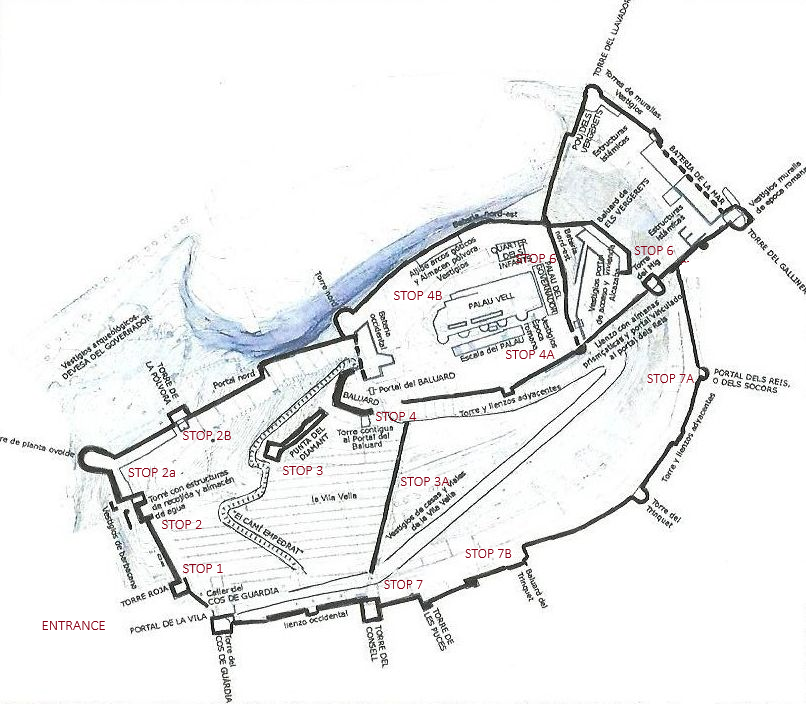Castle of Dénia Self Tour
Estimated Duration OF THE TOUR: 1.5–2 hours
Difficulty: Moderate (some slopes and uneven surfaces). NOT SUITABLE FOR PERSONS WITH REDUCED MOBILITY
Best Time to Visit: Morning or late afternoon (avoid midday heat IN SUMMER)
Please note that many of the descriptions are available only in Valencian
TIPS:
- Bring water, especially in summer.
- Comfortable shoes are a must.
- Combine your visit with a stop at the Archaeological Museum and the Ethnological Museum for full context (free entrance-Calle Caballeros 1-3).
POINTS OF INTEREST DURING THE VISIT (Check on the Map)
- Portal of the Vila (12th century) (Entrance)
- Tower of the Guard Corps
- Red Tower (15th century)
- Torre del Aljub (Cistern)
- Ovoid Tower
- Gunpowder Tower
- Tower of the Council (15th century
- Vila Vella (14th century) (Old Village)
- Baluard (Bastion)
- Portal of the Baluard
- Palau del Governador
- Paved Path (14th century)
- Punta del Diamant (17th century)
- Torre del Galliner
- Torre del Mig (11th century)
- Portal dels Reis or dels Socors

✅ START: Entrance – Portal de la Vila (Calle sant francesc)
- Features: Horseshoe arches, split keystone, Torre del Cos de Guardia (Tower of the Guard Corps)
- Interpretation: Main entrance to the castle during Islamic and Christian periods. Note the defensive features like the matacán (machicolation) and corner design.
- Tip: Look up to see preserved stonework and defensive architecture.
Stop 1: The Torre Roja (Red Tower)
- Built: 15th–16th centuries
- Use: Defensive tower with cannon embrasures
- Viewpoint: Offers excellent views over the old town and port
- Tip: Great for photos of the city and sea.
Stop 2: Path along the South Wall – Adarve or Ronda
- Interpretation: Restored walkway giving a sense of how guards patrolled the walls
- View: Marina Alta coast and surrounding countryside
- Optional: Continue to the Torre del Aljub (cistern tower) S. XV, Ovoid Tower and Gunpowder Tower
Stop 3: Vila Vella (Old Village ruins) AND punta del diamant (S. XVII)
- Follow the cobbled path uphill, once the only way to reach the ancient citadel
- Period: Islamic-medieval
- Features: Foundations of dwellings, narrow streets, historical interpretation panels
- Context: This was the heart of the walled Islamic town (Madīnat Dāniyya).
Stop 4: Portal del Baluard & Palau Vell
- Portal del Baluard: Defensive gate with bent access
- Stairs (4A)
- Palau Vell: Remains of the old Islamic/medieval palace (4B)
- Viewpoint: Scenic views to the south and Les Rotes
Stop 5: Palau del Governador (Governor’s Palace)
- Now: Exhibition space and viewpoint
- Formerly: Small museum of amphorae and artifacts (now in the Archaeological Museum)
- Interpretation: Shows the evolution of Dénia from Islamic stronghold to Renaissance seat of power
- Tip: End the tour here with panoramic views over the sea and Montgó mountain.
Stop 6: Torre del Mig (Middle TowEr) AND TORRE DEL GALLINAR (oPTIONAL)
- Built: 11th century
- Style: Islamic military architecture – bent entrance, double horseshoe arches, alfiz
- Importance: Once a main access between the albacar and the alcazaba
- Interpretation: A masterpiece of Taifa-era fortification.
Stop 7: Torre del Consell and walkways with view to the city
- Period: 15th century
- Use: Civil building used by the town council
- Architecture: Gothic rib vault, windows with views
- Interpretation: Symbol of transition from military to civil power
- Portal dels Reis or dels Socors and Walkways on the walls (7A and 7B)
Optional: The castle tunnel (BENEATH THE CASTLE NEAR THE TOURIST OFFICE)
- Where: Passes beneath the castle from Plaza del Consell to Ronda de les Muralles
- Built: Used as air-raid shelter during the Spanish Civil War
- Note: Ideal shortcut and cool escape from summer heat
